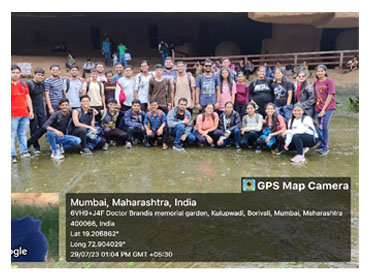Maratha Mandir’s
Babasaheb Gawde Institute of Management Studies
The Community Service Unit of Maratha Mandir’s Babasaheb Gawde Institute of Management Studies celebrated World Nature Conservation Day on Saturday 29th July 2023. The SYMMS students were taken to the Sanjay Gandhi National Park (Borivali East), a green haven in the midst of the concrete jungle of Mumbai.
The objective of this visit was to save our Flora and Fauna which is the backbone of life on the Earth; it is important to conserve them and save them from getting extinct, maintaining their right population that helps enrich the biodiversity.
The Sanjay Gandhi National Park, known as SGNP in short or also Borivali National Park has a long history dating back to the 4th century BC. In ancient India, Sopara and Kalyan were two ports in the vicinity that traded with ancient civilizations such as Greece and Mesopotamia. The 45 km (28 mi) land route between these two ports partially passed through this forest. The ancient Buddhist caves (Kanheri caves) served as rest houses for traders and travellers. The word Kanheri has originated from the Sanskrit word Krishnagiri meaning ‘Black Mountain’, probably because of the volcanic landscape, formed 45 to 60 million years ago.
The Kanheri Caves in the centre of the park were an important Buddhist learning centre and pilgrimage site sculpted by Buddhist monks between the 9th and 1st centuries BCE. They contain Buddhist sculptures and relief carvings, which were carved out of a massive basaltic rock outcropping, paintings and inscriptions, dating from the 1st century CE to the 10th century CE. The names of the donors who contributed towards the sculptures and carvings of the caves are inscribed in Brahmi and Kharosthi script.
SGNP itself is a diverse ecosystem that encompasses 104 sq. km The park is home to more than 280 bird species nearly 1,400 species of plants, 1,300 species of flowering plants, about 40 species of mammals, 61 species of reptiles, around 14 species of amphibians, 150 species of butterflies and an immeasurable array of other invertebrates and has a rich biodiversity. The city virtually encircles SGNP, with Vasai Creek to the north impeding the natural dispersal of leopards to the Tungareshwar Wildlife Sanctuary and other connected forests. The park is also home to two waterbodies, the Tulsi and Vihar lakes, that supply water to the city
Students prepared placards on conserving the flora and fauna and created awareness in the park. They were also shown a documentary by the SGNP Forest and Nature Trail group on protecting endangered species (Tigers) on International World Tiger Day. They also visited the Taxidermy Centre and Cat orientation centre at Sanjay Gandhi National Park.
Total of 42 students along with four faculty members visited Sanjay Gandhi National Park.
Learning- This visit developed a sense of responsibility to save the plants and animal kingdom as this earth belongs to all beings and not just human beings.
Feedback- The students had a wonderful visit and wished to have more such activities for them. They would love to contribute to saving mother earth.


